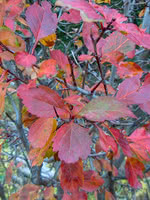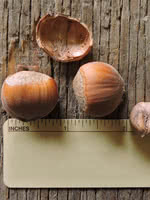Mon-Fri 9am - 5pm Mountain time
Black Hawthorn vs Aldara Hazelnut
Crataegus douglasii
Corylus heterophylla Het 3
NOT AVAILABLE THIS SEASON - MIGHT RETURN
NOT AVAILABLE THIS SEASON - MIGHT RETURN
Black Hawthorn is a versatile plant that is native to wetlands and other areas with moist soils, but can also tolerate dry soils. This plant can be grown as a short shrub, or a tree reaching 30 feet tall.
Black Hawthorn is valued for erosion control and attracting pollinators. It also makes an attractive flowering ornamental that can be planted as a specimen or pruned as a hedge. It is commonly used in shelterbelts.
Aldara Hazelnut is a northern hybrid selection noted for its superior nut quality, disease resistance, and cold hardiness.
It is great for attracting wildlife with the added bonus of edible nuts that can be eaten fresh or used in baking. Pair with another Aldara or Andrew Hazelnut for cross pollination to occur.
Aldara and Andrew Hazelnut are currently the hardiest and most reliable nut varieties available for the Canadian prairies.
Note: You want more than one hazelnut to improve yields.

